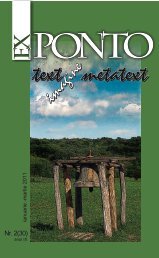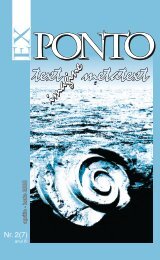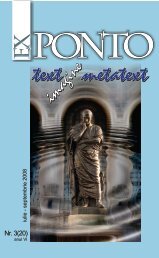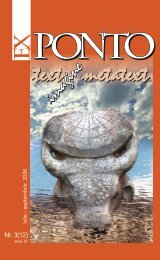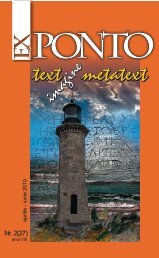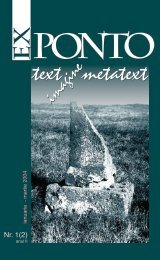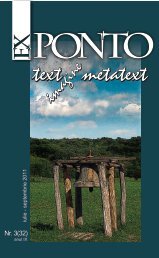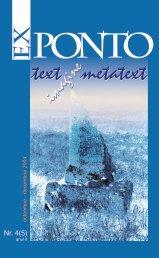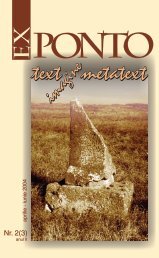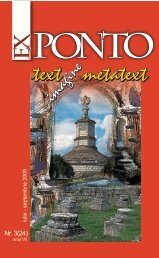Nr. 2 (19) anul VI / aprilie-iunie 2008 - ROMDIDAC
Nr. 2 (19) anul VI / aprilie-iunie 2008 - ROMDIDAC
Nr. 2 (19) anul VI / aprilie-iunie 2008 - ROMDIDAC
You also want an ePaper? Increase the reach of your titles
YUMPU automatically turns print PDFs into web optimized ePapers that Google loves.
(e.g. the avalanche and dinosaurs). Interestingly Gopo met his character in<br />
a medieval Romanian fresco at the monastery of Cozia:<br />
“I took the little man from the portico of the monastery Cozia, a parable<br />
fresco. The only difference is that in the fresco the character is round-headed<br />
(…). From the fresco painted by my ancestor I borrowed the thick line, the<br />
color, the yellowish beige.” 3<br />
This confession published in <strong>19</strong>63, in a more open context, clarified his<br />
position in regard to the ideological sources of his protagonist; it is not a<br />
Soviet allegory, instead it is a Romanian image, inspired by the one of the<br />
most representative sites for Romanianness. The fact that his character<br />
bears none of the features of a Soviet hero is an indication of Gopo’s correct<br />
evaluation of the historical context. In <strong>19</strong>56, at the Fourth Congress of the<br />
Romanian Workers’ Party, Gheorghe Gheorghiu-Dej, the leader of the party,<br />
announced the new national strategy of implementing “a Romanian way of<br />
building socialism,” and insisted upon “the necessity of respecting principles<br />
of national sovereignty.” 4 Thus, what apparently is “the most general topic:<br />
the role of man in the universe” 5 seems to be, at least, a coincidence, if not<br />
an ideologically influenced decision.<br />
The Short History also echoed some of the Zdanovite principles of Socialist<br />
Realism, according to which art should reflect progress and reality in order to<br />
educate people. The narrative thread of the cartoon simplistically presents a<br />
self-ironic theory of evolution and progress as a continuous staircase which<br />
reaches cosmic proportions with nuclear energy. The introduction of the nuclear<br />
energy symbol as a beneficent means of enhancing human progress is a<br />
circumstantial indication of the Russians’ industrial achievements in opening<br />
the first nuclear plant to generate electricity at Obninsk in <strong>19</strong>54. In the context<br />
of the Cold War, although Americans used nuclear power experimentally in<br />
<strong>19</strong>51, there was no chance for anybody from communist countries to think<br />
that Gopo would have known about the American experiment. Communist<br />
mass media was continuously censoring the positive aspects of American<br />
scientific and economic achievements. If he had known, he would not have<br />
dared to allude to the American achievement in atomic energy whatsoever.<br />
Nevertheless, Gopo’s cartoon deliberately ignored other aspects of Socialist<br />
Realism, such as “the revolutionary aspirations of the toiling masses building<br />
communism” 6 and, mainly, it transformed the truthfulness to nature and its<br />
relationship with art into a parody.<br />
Ex Ponto nr.2, <strong>2008</strong><br />
163




